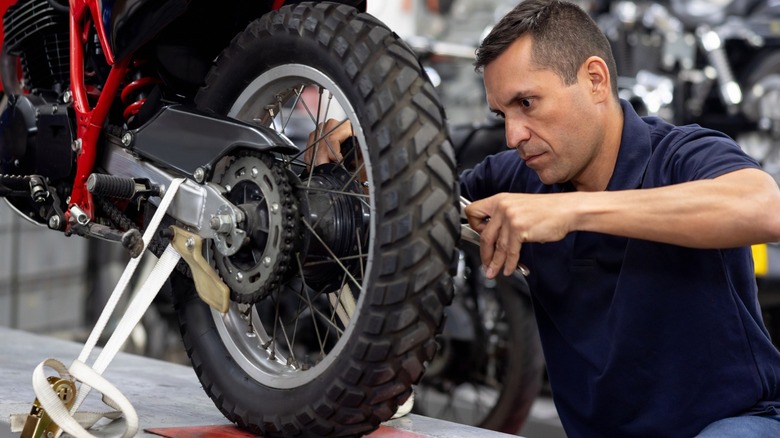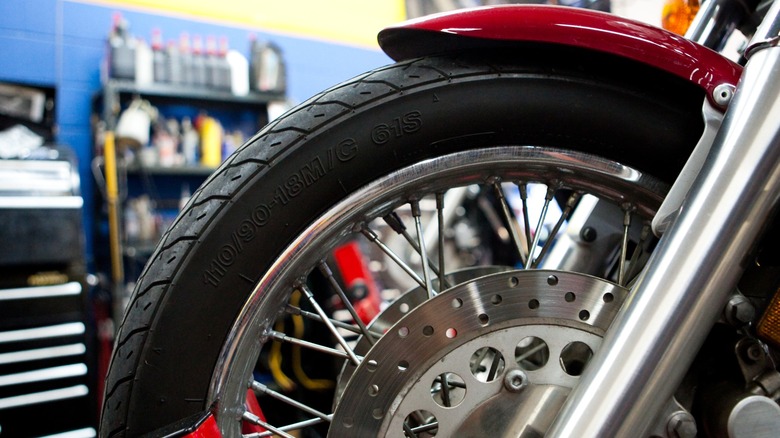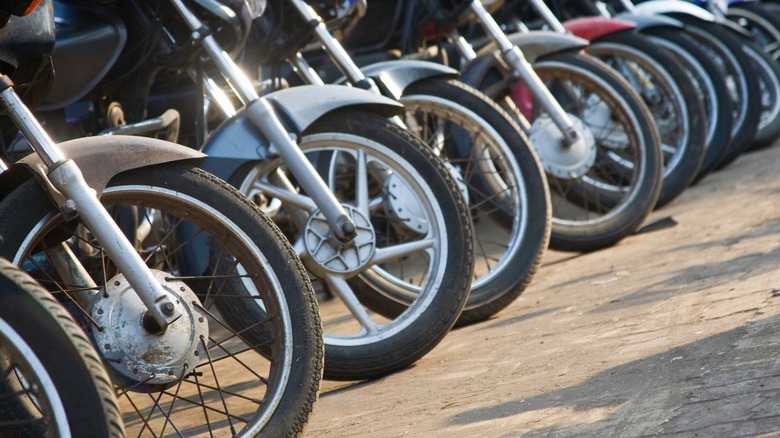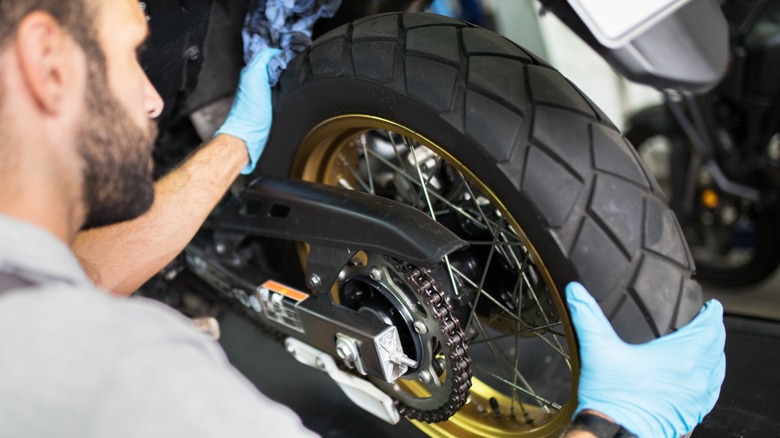
Andresr/Getty
If your bike’s handling feels off or you’re getting more flats than usual, it’s probably time to check your tires. While it might be a sign you need to balance your motorcycle’s tires, worn tread edges, cracks in the rubber, or even the slightest distortion in shape are all clear indications you may need to get a replacement instead. But how long do motorcycle tires really last, and how often should they be replaced? Well, it varies based on your riding habits, the terrain, and the tires themselves. However, one thing is certain: riding on worn-out tires is a risk no rider should take.
Advertisement
That said, you can’t just swap out your tires randomly. You have to choose the right size because the tire’s size has a major impact on how your bike performs. The wrong size can mess with the motorcycle’s handling, how well it brakes, and even how much fuel it consumes. In some cases, the wrong tire can be outright dangerous. In this article, we’ll take you through everything you need to know, including how to read tire size labels, why you should pay attention to your bike’s specs, and how to pick tires that fit your lifestyle and terrain perfectly.
Match the tires to your bike’s specs

Zarinmedia/Getty
There are two reliable ways to confirm the right size tires for your motorcycle. The first and most straightforward method is to check the sidewall of your current tires. You’ll find a series of numbers and letters stamped on the rubber that give you everything you need to know. For example, you might see something like 100/80-17 or 120/60ZR17. This combination of letters and numbers provides essential information such as the tire’s width, aspect ratio, rim diameter, speed rating, and construction.
Advertisement
These numbers do more than indicate the tire’s physical dimensions; they actually also give insight into how the tire will perform. For instance, a wider tire might improve stability, while a lower aspect ratio can enhance handling at higher speeds. But we’ll get to this in a bit.
The second way to confirm what size to get is to check your bike’s owner’s manual. Manufacturers specify the original tire size based on the specific needs of your motorcycle. Whether you’re riding a KTM or a Harley-Davidson cruiser, the manual will list the recommended tire size that ensures optimal handling and performance. Keep in mind that if you’ve upgraded your wheels, the size listed in the manual might no longer be accurate for your setup.
Advertisement
Understand how motorcycle tire size is labeled

Urbazon/Getty
Motorcycle tires often come in three main size formats: metric, alphanumeric, and numeric. While the metric format is the most common, especially for modern motorcycles, older or vintage bikes often use alphanumeric or numeric formats.
Advertisement
In the metric system, the numbers on the sidewall might look like 120/60ZR17. The first number (120) represents the tire’s width in millimeters, while the second number (60) is the aspect ratio, indicating that the tire’s sidewall height is 60 percent of the width. The letters and numbers that follow, such as ZR17, provide additional information about speed ratings and whether the tire is radial (R) or bias-ply.
The alphanumeric system is most commonly found on older motorcycles, like vintage Harley-Davidsons. An example might be MT90S-16. Here, MT is the code for the tire’s width, while 90 represents the aspect ratio, S represents the speed rating, and 16 is the diameter of the wheel in inches.
Advertisement
Finally, numeric sizing, which is also called the inch-based system and presented like 3.50-8, is used primarily on vintage motorcycles and sidecars. While less common today, it’s still important to know how to read this system if you’re riding or restoring an older model. In this system, 3.50 refers to the tire’s width in inches, and the number after the dash is the rim diameter in inches. If you’re heavy on the idea of custom bikes, you need to remember that different custom builds will certainly affect the mechanics of your bike.
Think about the load index and speed rating of the tire

Andresr/Getty
The load index is a number that shows how much weight a tire can handle when it’s properly inflated. You’ll usually find this number on the tire’s sidewall, right after the tire size. For instance, if you see something like 120/60ZR17 55 W, the number 55 represents the load index.
Advertisement
Each load index corresponds to a specific weight capacity. For example, a tire with a load index of 55 can support up to 481 pounds. If you go beyond this limit, the tire can overheat, wear out faster, or, in the worst case, fail altogether. So, you have to choose a tire with a load index that matches the manufacturer’s recommendations for your motorcycle.
The speed rating, on the other hand, tells you the maximum speed at which the tire can safely operate. It’s typically represented by a letter right after the load index number on the sidewall. For example, in the same 120/60ZR17 55 W, the W stands for a speed rating that indicates the tire can safely handle speeds up to 168 miles per hour.
Speed ratings range from letters like L (75 mph) for lower-speed tires to Z (149 mph or higher) for sport or high-performance motorcycles. While you may not reach the maximum speeds indicated by these ratings, it’s still important you select a tire with an appropriate speed rating. Using a tire with a speed rating that is too low can lead to premature wear or even tire failure, especially when you occasionally push the limit of the tires on the road.
Advertisement
Make sure the tire is compatible with the rim

Jagdish Agarwal/Getty
It’s tempting to go bigger when upgrading your motorcycle tires, but is it a good idea? You might think that fitting a wider tire will give your bike a more aggressive look or better traction, but it’s not always the case. The width of the tire is dictated by the size of the wheel rim. While you might be able to squeeze a wider tire onto a rim designed for a narrower one, doing so can negatively impact your bike’s handling. A wider tire will actually reduce the contact patch, giving you less grip on the road. On the flip side, trying to fit a narrower tire on a larger rim can also create handling problems. It can flatten out the tire’s profile, making your motorcycle handle more like a truck than a motorcycle .
Advertisement
For the best performance, always stick to the manufacturer’s recommended tire size. This way, your bike will handle just as the manufacturer intended and you will also prevent any potential damage to your swing arm, brake components, or fender. And while size is important, it’s not the only thing that matters. Tire quality is just as important, which is why knowing which brands to trust can make all the difference.
Think about the construction of the tire too

M_a_y_a/Getty
For a tire labeled 120/60ZR17, the R stands for radial construction. Meanwhile, in a tire labeled 180/65 B1, the B indicates bias-ply construction. While these tires may look similar in size, their construction leads to very different behavior on the road.
Advertisement
Bias-ply tires have been around for decades, long before radial tires became the standard for many motorcycles. These tires are constructed by layering cords from the bead (the part of the tire that makes contact with the rim) on one side of the tire across to the bead on the opposite side, alternating the direction of each layer. This crisscross design results in a sturdy, stiff sidewall that can withstand the demands of heavier bikes.
If you’re riding a cruiser or a touring motorcycle, bias-ply tires are a solid choice. Their thick sidewalls help evenly distribute the weight of the bike, making them ideal for long rides with heavy loads. However, because of their stiffness, they may not provide the same level of handling flexibility and comfort as radial tires.
Advertisement
Radial tires, introduced to the motorcycle world in the 1980s, brought a new level of performance. Unlike bias-ply tires, radial construction involves cords running directly across the tread rather than down the sidewalls. This design allows the sidewalls to be more flexible while keeping the tread stiffer for even better grip.
This flexibility gives radial tires the advantage when it comes to comfort and handling, particularly when you’re going at higher speeds. The sidewalls can absorb bumps more effectively, making them a better choice for sport bikes or performance-oriented motorcycles. Additionally, radial tires dissipate heat much faster than bias-ply tires, which helps them last longer.